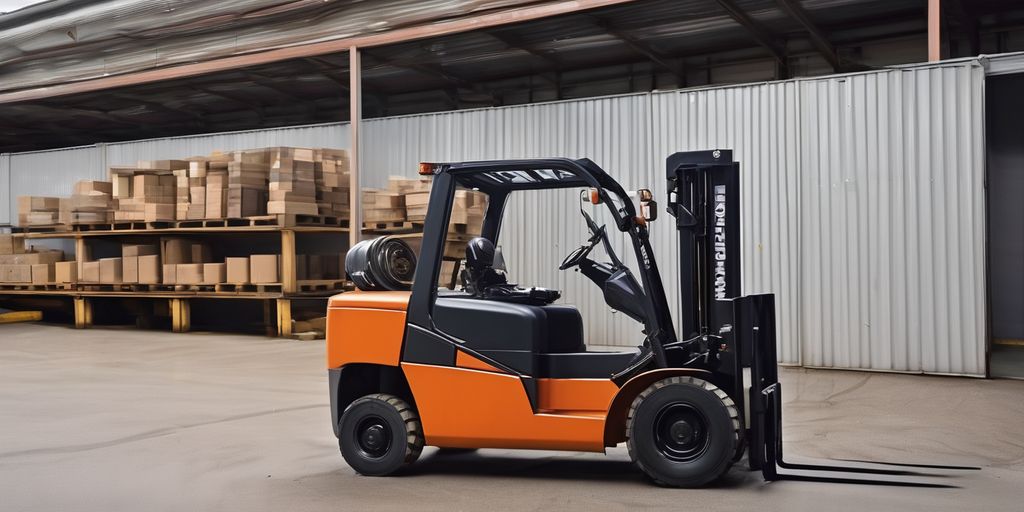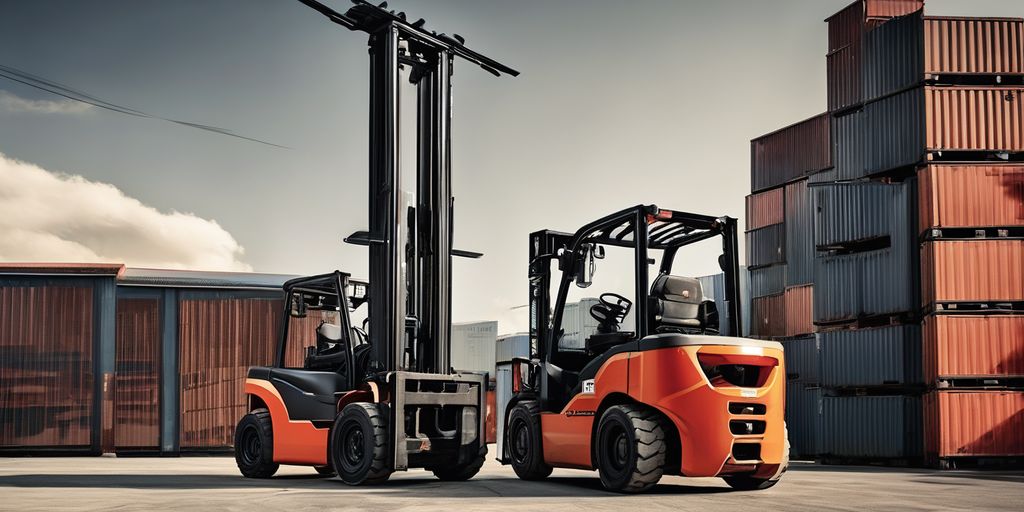Telehandler forklifts, also known as telescopic handlers or telehandlers, are indispensable machines in the construction industry. These versatile and powerful tools are designed to lift, move, and place heavy materials with precision and ease. Whether you're navigating rough terrain or handling bulky building materials, telehandler forklifts provide the heavy-duty solutions needed to get the job done efficiently and safely.
Key Takeaways
- Telehandler forklifts are versatile machines essential for lifting and moving heavy materials on construction sites.
- They come in various sizes, including small, medium, and large, to suit different job requirements.
- Telehandlers are designed to navigate rough terrains, making them ideal for construction sites with uneven surfaces.
- Routine maintenance and regular inspections are crucial to ensure the longevity and optimal performance of telehandler forklifts.
- Innovations in telehandler technology have led to advancements in safety, maneuverability, and eco-friendliness.
Understanding Telehandler Forklifts
Telehandler forklifts, also known as telescopic handlers, combine the benefits of both forklifts and cranes. They offer unmatched versatility by allowing operators to move cargo vertically and horizontally with precision. This makes them ideal for working in confined spaces and around obstacles. Additionally, telehandlers can traverse rough terrain and remain stable on uneven ground, making them indispensable on construction sites.
Key Features of Telehandler Forklifts
Telehandlers come with a variety of features that enhance their functionality:
- Telescopic Boom: Allows for extended reach both vertically and horizontally.
- Multiple Attachments: From forks to buckets, telehandlers can handle various types of loads.
- All-Terrain Capability: Equipped with robust tires to navigate rough and uneven surfaces.
Advantages of Using Telehandler Forklifts
The primary advantages of telehandler forklifts include:
- Versatility: Can be used for lifting, moving, and placing materials at different heights and distances.
- Efficiency: Reduces the need for multiple machines on a job site.
- Safety: Designed to handle heavy loads while maintaining stability.
Common Applications in Construction
Telehandlers are commonly used in construction for:
- Handling Heavy Building Materials: Ideal for lifting and placing materials like bricks, blocks, and steel beams.
- Navigating Rough Terrain: Their all-terrain capability makes them suitable for uneven job sites.
- Safety Considerations: Built with safety features to ensure secure operation even in challenging conditions.
Telehandler forklifts are a crucial asset in the construction industry, offering a blend of versatility, efficiency, and safety that few other machines can match.
Types of Telehandler Forklifts
Telehandler forklifts come in various sizes and configurations to meet the diverse needs of construction sites. Understanding the different types can help you choose the right equipment for your specific tasks.
Telehandler Forklifts for Construction Sites
Handling Heavy Building Materials
Telehandler forklifts are essential for efficiently handling heavy building materials on construction sites. With their telescopic booms, these machines can reach impressive heights and distances, making it easier to position materials exactly where needed. This capability is particularly useful for stacking and loading heavy items, such as pallet-sized units or large objects that fit on the pallet forks.
Navigating Rough Terrain
Construction sites often feature rough and uneven surfaces, which can be challenging for standard forklifts. Telehandler forklifts, however, are equipped with all-terrain tires that provide superior traction and stability. This allows them to navigate difficult job site conditions with ease, ensuring that materials are transported safely and efficiently.
Safety Considerations
Safety is a paramount concern when operating telehandler forklifts on construction sites. Operators must be trained to handle these powerful machines properly, and regular maintenance and inspections are crucial to ensure their safe operation. Additionally, telehandlers often come with advanced safety features, such as load stability indicators and enhanced maneuverability controls, to help prevent accidents and injuries.
When considering telehandlers for sale in Chicago, Illinois, it's important to look for models that offer robust safety features and reliable performance. This ensures that the equipment can handle the demands of a busy construction site while keeping workers safe.
Choosing the Right Telehandler Forklift
Selecting the appropriate telehandler forklift for your construction site is crucial for operational efficiency and safety. Understanding your specific needs will guide you in making the best choice.
Assessing Load Capacity Needs
When choosing a telehandler forklift, it's essential to consider the heaviest loads you'll need to lift. Many people tend to underestimate this, so when in doubt, opt for a larger capacity. Telehandlers with telescopic booms often come with load charts to help you determine the forklift's load capacity.
Evaluating Reach and Height Requirements
Deciding between high reach and high capacity models can be challenging. Consider the maximum height and reach you'll need for your projects. Telehandlers with telescopic booms can reach significant heights and distances, making them versatile for various tasks.
Considering Terrain and Job Site Conditions
The terrain of your job site plays a significant role in your telehandler choice. All-terrain tires are beneficial for navigating rough and uneven surfaces. Ensure the telehandler you choose can handle the specific conditions of your site.
Choosing the right size telehandler can help you get the most out of your purchase. Evaluate your job site conditions and operational needs carefully to make an informed decision.
Maintenance and Care for Telehandler Forklifts

Routine Maintenance Tips
Regular maintenance is crucial for ensuring the longevity and performance of telehandler forklifts. Maximizing efficiency with the right fork truck attachments can significantly reduce wear and tear. Key maintenance tips include:
- Regularly checking and replacing hydraulic fluids
- Inspecting tires for wear and proper inflation
- Ensuring all moving parts are well-lubricated
- Conducting regular engine checks and oil changes
Common Issues and Troubleshooting
Telehandler forklifts can encounter various issues that require prompt attention. Some common problems include hydraulic leaks, engine malfunctions, and electrical issues. Preventative maintenance services can help identify and address these issues before they become major problems. Troubleshooting steps include:
- Identifying the source of the problem
- Consulting the operator's manual for guidance
- Seeking professional repair services if necessary
Importance of Regular Inspections
Regular inspections are essential for maintaining the safety and efficiency of telehandler forklifts. Routine inspections help in identifying potential issues early, ensuring that the equipment remains in optimal condition. Key inspection points include:
- Checking the structural integrity of the boom and chassis
- Verifying the functionality of safety features
- Ensuring that all controls and indicators are working correctly
Regular inspections and maintenance not only extend the lifespan of telehandler forklifts but also ensure a safer working environment for operators.
Innovations in Telehandler Forklift Technology
Telehandler forklifts have seen significant advancements in recent years, driven by the need for enhanced efficiency and safety in material handling. One of the top trends in forklift technology includes the integration of automation and autonomous mobile robots (AMRs). These innovations are shaping the industry's future by reducing the need for manual operation and increasing precision in tasks.
Advancements in Safety Features
Modern telehandler forklifts are equipped with cutting-edge safety features such as collision detection systems, automatic load balancing, and enhanced operator visibility. These features are crucial for preventing accidents and ensuring a safer working environment on construction sites.
Enhanced Maneuverability and Control
The introduction of rotating telehandlers has revolutionized the industry. Unlike standard telehandlers, these innovative machines offer a pivotal advantage with their 360-degree maneuverability. This feature allows operators to position loads with greater accuracy and efficiency, even in confined spaces.
Eco-Friendly and Energy-Efficient Models
The future of forklift technology is also leaning towards sustainability. Electric telehandler forklifts are becoming more popular due to their lower emissions and reduced operational costs. Additionally, advancements in battery technology and energy-efficient designs are making these models more viable for long-term use.
The future of forklift technology is bright, with innovations driving industry trends. Focus on electric forklifts, IoT connectivity, and predictive maintenance for enhanced efficiency and safety in material handling.
Renting vs. Buying Telehandler Forklifts
Cost Considerations
When deciding between renting or buying a telehandler forklift, cost is a major factor. Renting can be more economical for short-term projects, while purchasing may be a better investment for long-term use. Here's a quick comparison:
| Option | Daily Rate | Weekly Rate | Monthly Rate |
|---|---|---|---|
| Renting | $398 | $942 | $2,708 |
| Buying | - | - | - |
Flexibility and Convenience
Renting offers significant flexibility and convenience, especially for projects with fluctuating demands. You can easily scale your equipment needs up or down without the long-term commitment of ownership. This is particularly beneficial for operations that require temporary forklifts to support seasonal activities.
Long-Term vs. Short-Term Needs
For long-term projects, buying a telehandler forklift might be more cost-effective in the long run. However, for short-term or unpredictable projects, renting provides the advantage of accessing a wide inventory without the burden of maintenance and storage.
Renting can offer more flexibility to an operation, allowing managers to adapt quickly to changing project requirements.
Conclusion
Telehandler forklifts are indispensable assets on construction sites, offering unparalleled versatility and power for material handling tasks. From small to large models, these machines are designed to tackle a wide range of jobs, from light-duty to heavy-duty applications. Their ability to navigate rough terrains and reach otherwise inaccessible areas makes them a crucial tool for any construction project. Investing in a telehandler forklift can significantly enhance your operational efficiency and productivity. If you're considering adding one to your fleet, Uforklift offers a variety of options to meet your specific needs. Contact us today to find the perfect telehandler forklift for your construction site.
Frequently Asked Questions
What is a telehandler forklift?
A telehandler forklift is a versatile lifting machine equipped with a telescopic boom that can extend forward and upward. It is commonly used in construction sites for lifting and placing heavy materials.
What are the key features of telehandler forklifts?
Key features of telehandler forklifts include a telescopic boom, high load capacity, all-terrain tires, and the ability to reach high places. Some models also come with advanced safety features and enhanced maneuverability.
What are the advantages of using telehandler forklifts in construction?
Telehandler forklifts offer several advantages in construction, including the ability to lift heavy materials to great heights, navigate rough terrain, and perform multiple tasks with various attachments. They improve efficiency and safety on construction sites.
How do I choose the right telehandler forklift for my needs?
To choose the right telehandler forklift, assess your load capacity needs, evaluate the reach and height requirements, and consider the terrain and job site conditions. It's also important to consider whether you need a small, medium, or large telehandler.
What maintenance is required for telehandler forklifts?
Routine maintenance for telehandler forklifts includes regular inspections, checking fluid levels, cleaning filters, and ensuring that all moving parts are well-lubricated. Addressing common issues and troubleshooting promptly can prevent major repairs.
Should I rent or buy a telehandler forklift?
The decision to rent or buy a telehandler forklift depends on your specific needs. Renting offers flexibility and convenience for short-term projects, while buying is more cost-effective for long-term use. Assess your budget, project duration, and frequency of use to make an informed decision.




Deja un comentario
Este sitio está protegido por reCAPTCHA y se aplican la Política de privacidad de Google y los Términos del servicio.